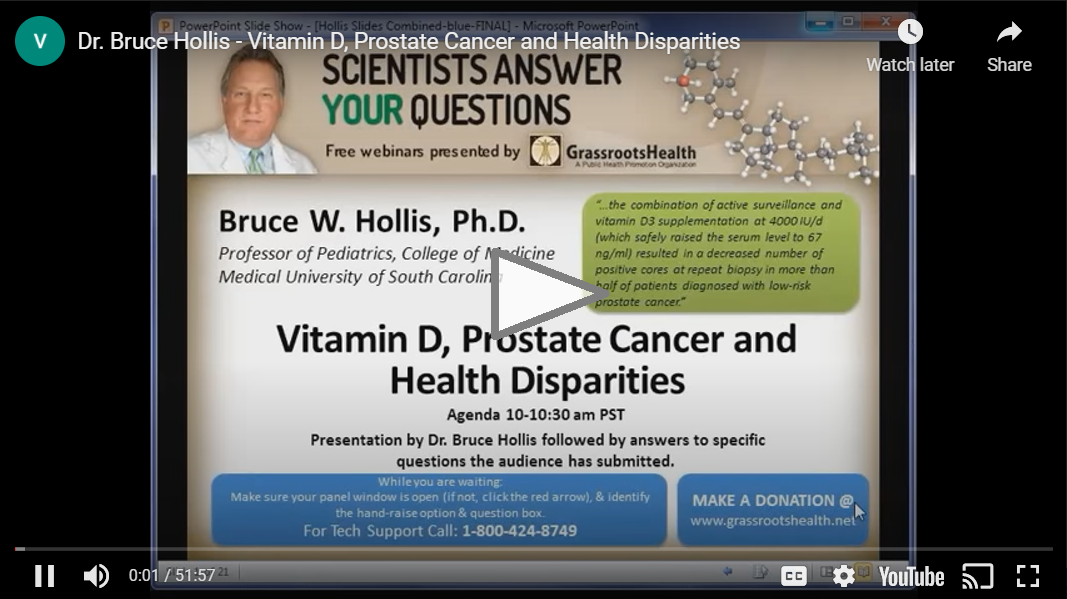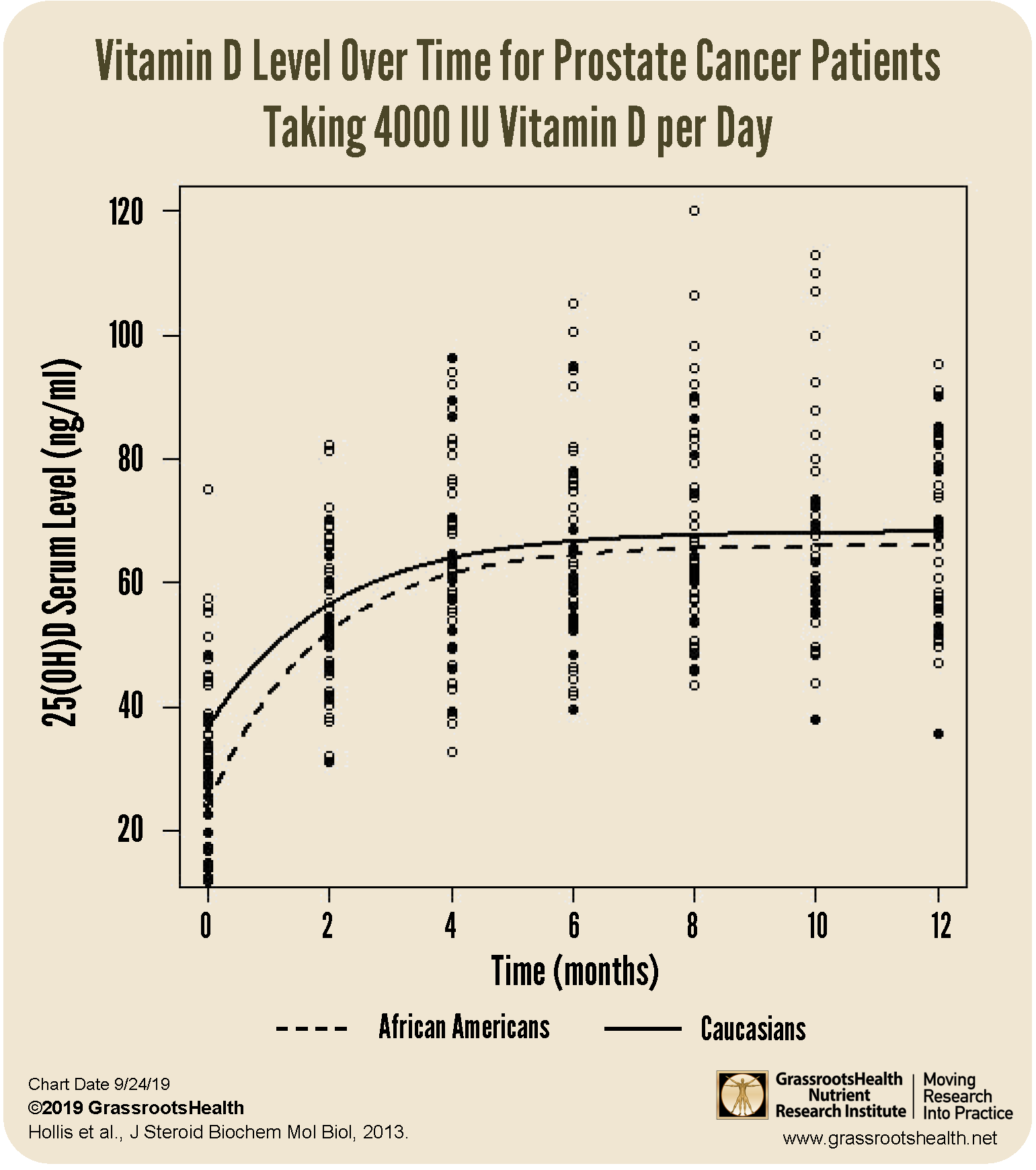Published on September 23, 2022
September is Prostate Cancer Awareness Month. Share this information and success story to spread the awareness of vitamin D for prostate cancer.
 One out of seven men will get prostate cancer in their lifetime. Since it is prostate cancer awareness month, we wanted to take the opportunity to remind everyone about research findings on vitamin D and prostate cancer.
One out of seven men will get prostate cancer in their lifetime. Since it is prostate cancer awareness month, we wanted to take the opportunity to remind everyone about research findings on vitamin D and prostate cancer.
Vitamin D has known anticancer effects, and much research has been published over the last several decades showing a link between vitamin D levels and cancer risk. Depending on the type of cancer, vitamin D alone can potentially reduce the risk of cancer by about 25% to 80%!
Unfortunately, according to National Health and Nutrition Examination Survey (NHANES, 2009-2014) data, almost 90% of U.S. adults in the NHANES data set have a vitamin D level below the recommended range of 40-60 ng/ml.
Vitamin D Success Story: Prostate Cancer
One participant shared his story with GrassrootsHealth about his diagnosis of prostate cancer, his choice to bypass surgery and chemo, and to instead supplement with high-dose vitamin D. His cancer is no longer detectable, and he continues to monitor his vitamin D levels in order to keep it within his target.
Findings on Vitamin D and Prostate Cancer
Dr. Bruce Hollis, a GrassrootsHealth scientist panel member, was one of the first to study giving “larger” doses of vitamin D (4,000 IU per day) to participants, something that was difficult to get approval for before 2010. (He was the first to get permission to give 4,000 IU/day for research back in 2007.)
Hollis and colleagues ran an intervention study at the Medical University of South Carolina (MUSC) on 52 men who had been diagnosed with stage 1 prostate cancer. They purposely did not conduct an RCT as they wished to give everyone in the study vitamin D. They used a dose of 4,000 IU/day of vitamin D for one full year while the participants were on a “wait and see” approach with their cancer.
In the video below, Dr. Hollis describes the study and its findings in detail.
The overall result was that almost 60% had a reduction in tumors (but no change to prostate-specific antigen) as opposed to doing nothing (they compared against non-participants and historical data).
Of the 52 men, 15 (29%) went from a Gleason score of 6 (stage 1 or 2 cancer) to a Gleason score of 0 (no cancer cells detected).
Is 4000 IU/day the right amount for you?
In considering differences by race, the chart below shows that while African Americans started with a vitamin D level of about half the value of Caucasians, after a year of taking 4,000 IU/day both race groups reached roughly the same vitamin D level (a mean of 60 ng/ml or 150 nmol/L).
An important note to take away from the chart is that at the 12 month mark, while the mean vitamin D level was 60 ng/ml (150 nmol/L), there is a wide range of resulting levels after supplementing with 4,000 IU per day. There is one as low as 38 ng/ml (95 nmol/L) and one near 95 ng/ml (237 nmol/L). This is another reminder of the wide variability in how each person responds to vitamin D supplementation, and especially, the importance of testing your level and focusing on the serum level rather than the dose as the appropriate biological marker.
Other Important Cancer Fighting Co-Nutrients
Don’t forget that vitamin D works along with other essential nutrients for our health. For anti-cancer effects, these include:
- Omega-3s for non-melanoma skin cancers
- Magnesium for cancer in general
- Vitamin C
- Selenium
Are you getting enough vitamin D and other nutrients to help prevent or reduce cancer?
 Having and maintaining healthy vitamin D levels and other nutrient levels can help improve your health now and for your future. Choose which to measure, such as your vitamin D, omega-3s, and essential minerals including magnesium and zinc, by creating your custom home test kit today. Take steps to improve the status of each of these measurements to benefit your overall health. You can also track your own intakes, symptoms and results to see what works best for YOU.
Having and maintaining healthy vitamin D levels and other nutrient levels can help improve your health now and for your future. Choose which to measure, such as your vitamin D, omega-3s, and essential minerals including magnesium and zinc, by creating your custom home test kit today. Take steps to improve the status of each of these measurements to benefit your overall health. You can also track your own intakes, symptoms and results to see what works best for YOU.
Enroll and test your levels today, learn what steps to take to improve your status of vitamin D (see below) and other nutrients and blood markers, and take action! By enrolling in the GrassrootsHealth projects, you are not only contributing valuable information to everyone, you are also gaining knowledge about how you could improve your own health through measuring and tracking your nutrient status, and educating yourself on how to improve it.
Test Now







